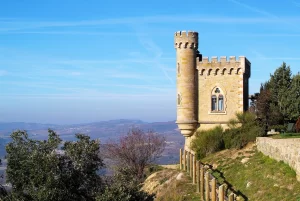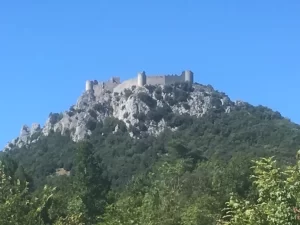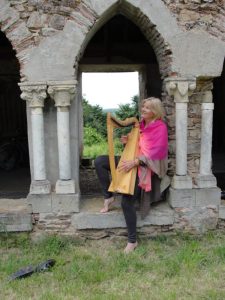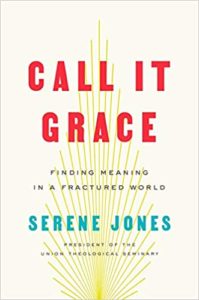Woody Guthrie
Dayle in Limoux – Day #62
September 5, 2022Reading today about the influences of Saint-Catherine of Alexandria, beloved of the Beguines and Joan of Arc’s spiritual voice and influence. She was 22 when she was tortured and murdered because she refused to marry an Egyptian emperor. She was killed in the year 305.
Britannica: She protested the persecution of Christians under the Roman emperor Maxentius—whose wife and several soldiers she converted while imprisoned—and defeated the most eminent scholars summoned by Maxentius to oppose her. During her subsequent torture, she professed that she had consecrated her virginity to Jesus Christ, her spouse, and was sentenced to death. The spiked wheel by which she was to be killed broke when she touched it (whence the term Catherine wheel), and she was then beheaded.
The wheel was a horrific way to die a slow, excruciating death. This is why we often see Catherine depicted with a wheel.
From the book, The Wisdom of the Beguines/The Forgotten Story of a Medieval Women’s Movement, by Laura Swan,
The Beguines chose four women who they felt had proclaimed the gospel for their lives: the apostle Mary Magdalene, the martyrs Saint Catherine of Alexandria, and Saint Agnes, and the abbess of Andenne, Begga. You smile with delight (p. 50).
Beguines were a powerful expression of the vita apostolic, being ‘apostolic life’ or ‘the life of an apostle.’ They pooled their resources in order to serve the sick and destitute by building and operating infirmaries and almshouses (p. 17, 19). Many beguines used their sources of income to purchase homes near the chapel or parish church where they gathered together for prayer (p. 15).
Many women became beguines as a result of their newfound literacy (p. 21). Beguinages endured the ravages of war and plague, hostile politics and shifting cultural attitudes […] some managed to survive all the way into the twentieth century (67). Beguines were not nuns (p. 13). Nuns were steady supporters of the beguines (p.15).
Some of the beguines were considered ‘heretics,’ of course. When men didn’t agree with women’s motives or rhetoric, they were ‘heretics.’ One beguines, Marguerite Porete, a larned beguines preacher and writer, was sentenced by the Inquisition to be burned at the stake. She was a learned beguine preacher and writer, and was murdered on June 1, 1310. Her crime? Her work of mystical theology called, ‘The Mirror of Simple Souls,’ which she had composed in Old French and shared with others.
M
A
R
I
A
N
N
E
She loves me when I act wisely, and she loves me when I am foolish. Her love is based not on how I’ve acted but on who I am. He knows who I am, for She created me. The Beloved’s love is unconditional.
My errors do not call for God’s punishment, but for His correction. As I atone for my mistakes—willing to make amends with a repentant heart—then His merciful hand will reorder events and allow me new beginnings. Such is the miracle of a merciful, non-judgmental God, the source of all good and the reason for my unending praise.
How awesome is the Beloved, for even when I have fallen from grace – from the truth within me, from the love that is the meaning of my life – She loves me still, allowing me new life, again and again.
My gratitude is deep.
The light, pours in through the cracks.
From the Dalai Lama, a reminder this morning:
All 7 billion human beings have a common experience—we all appreciate love. We all have a seed of love and affection within us and the potential to cultivate greater love and compassion. If we want to create peace in the world it has to start with the heart, with inner peace.
Julian of Norwich called this love ‘a love without beginning.’
✠
I came across an essay in my research today I haven’t seen in a while. It is so beautifully and intellectually written by a fellow explorer who was a part of our sacred mystery tour here in Languedoc in 2019. His name is Andrew Cowie.
My first fleeting glimpse of the near-mythical French village of Rennes-le-Chateau was suitably mysterious. Perched atop a majestic cliff in the foothills of the Pyrenees, she peeked out briefly and tantalisingly from behind a murky veil of mist before swiftly vanishing again, leaving behind only more questions and very little by way of answers. This murky first encounter seemed somehow to encapsulate everything about this magical village and the labyrinthine web of mysteries which entangles it – a place full of wonder and intrigue, its secrets forever elusive, the answers always remaining just slightly out of reach. Rennes-le-Chateau attracts tens of thousands of tourists every year, many of them treasure hunters drawn to the area’s rich history and mythology.
[Rennes-les-Chateau]
Legends of buried treasure abound here, with the village thought by many to be the location of the riches of the Knights Templar or the Cathars, the resting place of the Holy Grail or the Ark of the Covenant. Some believe it to contain the tombs of Jesus and Mary Magdalene, while others claim it to be the site of a subterranean extra-terrestrial base. The area is a conspiracy theorist’s paradise and it’s easy to see why it has attracted this reputation.
[Le château de Montségur, one of the last refuges for the Cathars, who, in mass, were burnt in giant pyres in the field below in 1244.]
Everything about this place, and the wider region of Languedoc, is jaw-droppingly bizarre, from geological anomalies and precise geometric alignments to extraordinary natural phenomena and a chain of endless peculiar synchronicities which cannot simply be dismissed as chance. Indeed, the further I ventured down the veritable rabbit warren of the Rennes-le-Chateau mystery, the more I realised that the truth is much, much stranger than any fiction my writer’s imagination could ever conjure.
It’s a thoughtful and passionate piece. Andrew is a former journalist; he wrote this about a year after our return, in 2020. He lives in Scotland. It will give you a great foundation for learning more about the mysteries of Languedoc, sacred geometry, and Rennes-les-Chateau. Here’s a link to the full essay.
https://www.phoenixcoaching.co.uk/post/holy-grail-the-mysterious-treasure-of-rennes-le-chateau
I’ve been listening to a lot of Ani William’s music since I’ve been back in France. Ani is a world-renowned harpist and singer, and has recorded more than two-dozen albums of original sacred music based on ancient spiritual traditions. She has done seminal work in the study of sound healing and the relationship between musical tones, the human voice and healing.
Here she is singing Aramaic Lord’s Prayer at Rennes-le-Chateau. Extraordinary.
The lyrics, the Aramaic Our Father:
Heavenly Source
You Who are everywhere
Thy Kingdom come
Your will be done
Here and ow and for evermore.
Fill us with the power of your mercy
And free us from the fetters with which we bind each other.
Lead us out of temptation: free us from ourselves.
And give us the strength to be one with You.
Teach us the true power of forgiveness.
May this holy moment be the ground
From which our future actions grow.
Amen.
-The Manuscript, p. 440
From Ani’s website: The prayer knows no gender, and celebrates the Light and Sound of Creation, inviting this into our Holy of Holies within. This video was filmed in the chapel of Mary Magdalene. [https://aniwilliams.com]
L A B O R
D
A
Y
U.S. states and activists started celebrating the labor force in the late 1800’s. New York was the first state to introduce a bill, yet Oregon was the first state to codify it into their state law. ‘Labor Day honors and recognizes the American labor movement and the works and contributions of laborers to the development and achievements of the United States’ [wikipedia].
Mother Teresa:
“The miracle is not that we do the work, but that we are happy to do it.”
Some captures from earlier Labor Day honors.
Roller skates and sashes. Can’t think of a better way to celebrate. Beats buying a mattress.
And a song from Woody Guthrie, about 1,200 striking coal miners and their families in Ludlow, Colorado on April 20, 1914. It refers to the violent deaths of 20 people, 11 of them children, during an attack by the Colorado National Guard on a tent colony there in Ludlow. The clip features the late historian, author, and activist Howard Zinn.
Bonne nuit.
✌🏻
4 from Bruce.
May 20, 2021Bruce Springsteen receives the 2021 Woody Guthrie prize. Here’s the full setlist, his homage to Woody.
1) Tom Joad
2) Deportee
3) Across the Border
4) The Ghost of Tom Joad
‘Bruce Springsteen has been awarded the annual Woody Guthrie Prize. He will accept the honor on May 13th during a virtual event for Woody Guthrie Center members. “I’m honored to receive the 2021 Woody Guthrie Prize,” Springsteen said in a statement.’ [Rolling Stone]
“Woody wrote some of the greatest songs about America’s struggle to live up its ideals in convincing fashion,” Springsteen said in a statement.
Bruce’s community.
January 15, 2021‘The first half of Bruce Springsteen’s autobiography makes some things abundantly clear:
He had no natural ability to play the guitar. In fact, after his first lessons, he quit, unable to play a note.
He had no singing talent. Every group he was part of needed a lead singer, and it wasn’t him.
And just about everyone dismissed him. Audiences walked out, his first agent simply stopped returning his calls and bandmates gave up and moved on.
He didn’t even know how to drive a car. Not only wasn’t he dating in high school, he wasn’t even cruising around town, being a charismatic rock star.
Talent is overrated. Skill is acquirable.
Showing up is something almost every creative leader has in common. In business, in the arts, in society. Consistently shipping the work, despite the world’s reaction, despite the nascent nature of our skill, despite the doubts.
And community is essential. The people you surround yourself with can reinforce your story, raise the bar and egg you on.
After the fact, the community becomes an integral part of your story of success. But first, you have to commit to the journey.’
-Seth Godin, author
“Writing about yourself is a funny business…but in a project like this, the writer has made one promise, to show the reader his mind.”
-Bruce
Can we agree at least on this?
On Being
December 8, 2019The Pause
Loving the Questions
In 1974, a 15-year-old Serene Jones sat at a campfire sing-along that helped shape her understanding of America and its complicated relationship to its own story. She and her fellow campers were singing along to the familiar lyrics of Woody Guthrie’s “This Land Is Your Land” when she learned for the first time that the song actually has a few lesser-known verses, including:
“In the shadow of the steeple I saw my people,
By the relief office I seen my people;
As they stood there hungry, I stood there asking
Is this land made for you and me?”
She writes in her book Call it Grace bout how hearing these more critical lyrics to a popular American song was a moment of revelation. Even decades later, she’s held onto the memory as a metaphor for America’s tendency to shine light on the “sunny, hopeful, and helpful” while “[lopping] off the uncomfortable verses about our lives.”
And in this week’s On Being, Jones talks about how her work as a public theologian is about reconciling these two realities in humanity: Both our propensity for love and connection, as well as our capacity for hatred and cruelty. She says it’s the work of connecting our personal stories to this bigger question — what does it mean to be human? — that makes theology such an important exercise. “What is theology, if it’s not talking about our collective lives and the meaning and purpose of our lives and how we’re supposed to live together and who God is, in ways that are part of our conversation together?”
Serene Jones describes theology as the place and story you think of when you ask yourself about the meaning of your life, the world, and the possibility of God. For her, that place is a “dusty piece of land” on the plains of Oklahoma where she grew up. “I go there to find my story — my theology. I go there to be born again; to be made whole; to unite with what I was, what I am, and what I will become.” In her work as a public theologian, Jones explores theology as clarifying lens on the present — from grace to repentance to the importance of moving from grieving to mourning.
Rilke:
“Be patient toward all that is unsolved in your heart and try to love the questions themselves, like locked rooms and like books that are now written in a very foreign tongue,” he wrote. “Do not now seek the answers, which cannot be given you because you would not be able to live them. And the point is, to live everything. Live the questions now. Perhaps then, someday far in the future, you will gradually, without even noticing it, live your way into the answer.”
Be good.
July 3, 2019
#RunForSomething
♡
‘Whether you are a Republican or a Democrat, if you know someone who ought to run for something, or if you ought to run for something, the thing you ought to run for is the state legislature in your state. And you better do it right now.’ [Maddow Blog]
There is only one true flight from the world: it is not an escape from conflict, anguish, and suffering, bu the flight from disunity and separation, to unity and peace in the love other (wo)men.”
Thomas Merton, New Seeds of Contemplation
What does is mean to be good? This is not something people talk about, or agree on much of these days.
“You have to love a nation that celebrates its independence every July 4, not with a parade of guns, tanks, and soldiers who file by the White House in a show of strength and muscle, but with family picnics …”
-Erma Bombeck
Happy 4th. ❥
‘Everybody wondered why…’
July 22, 2018Richard Rohr, Center for Action and Contemplation
More than a theological statement that requires intellectual assent, the Eucharist is an invitation to socially experience the shared presence of God, and to be present in an embodied way. Remember, within a Trinitarian worldview, everything comes down to relationship.
First, let me share some context. In Jesus’ time, the dominant institution was the kinship system: the family, the private home. That’s why early Christians gathered in house churches, much different from the typical parish today. In Matthew’s Gospel the word house is used many times. Jesus is always going in and out of houses (as in 8:14, 9:10). What happened around the tables in those houses shaped and named the social order. Table friendship ends up defining how we see friendship in general.
Jesus often used domestic settings to rearrange the social order. Nowhere was that truer than with the meal—with whom, where, and what he ate. This is still true today, more than we might imagine. (Another example of Jesus changing the social order is in the relationship between employers and workers.) Jesus’ constant use of table relationships is perhaps his most central re-ritualization of what family means. Note that he is always trying to broaden the circle (see Luke 14:7-24 for three good examples). Jesus brought this all to fullness in his “last supper” with “the twelve.” This was not to emphasize male fellowship, but the full quorum of the twelve tribes of Israel. (I know it does not look that way to us now, but the Eucharistic meal was from the very beginning a gathering of both women and men, which shows how Christians understood equality.)
Jesus didn’t want his community to have a social ethic; he wanted it to be a social ethic. Their very way of eating and organizing themselves was to be an affront to the system of dominance and power. They were to live in a new symbolic universe, especially symbolized by what we now call open table fellowship.
In all cultures, sharing food is a complex interaction that symbolizes social relationships and defines social boundaries almost more than any other daily event. Whom you eat with defines whom you don’t eat with. Certain groups of people eat certain kinds of food. Through our choices and behavior at table, we name and identify ourselves.
This might seem like an unfair example to some, but today a vegetarian (or even vegan) diet has become a conscious choice for many because they’ve studied the politics of food: who eats meat and who can’t eat meat; what eating meat is doing not only to our health but even to the planet. Researchers surmise that the meat-heavy Western diet contributes to one-fifth of global emissions on our planet. Zen master Thich Nhat Hanh writes:
As a spiritual family and a human family, we can all help avert climate change with the practice of mindful eating. Going vegetarian may be the most effective way to stop climate change.
Jesus already showed us in practice and in ritual that the spiritual, social, political, and economic move together as one. In fact, that is what makes something “spiritual”—that is whole, combining sacred and secular, matter and spirit.
*Thich Nhat Hanh, “Blue Cliff Letter,” 2007, https://plumvillage.org/letters-from-thay/sitting-in-the-autumn-breeze/.
*Adapted from Richard Rohr with John Bookser Feister, Jesus’ Plan for a New World: The Sermon on the Mount (St. Anthony Messenger Press: 1996), 67-68, 77-79.












